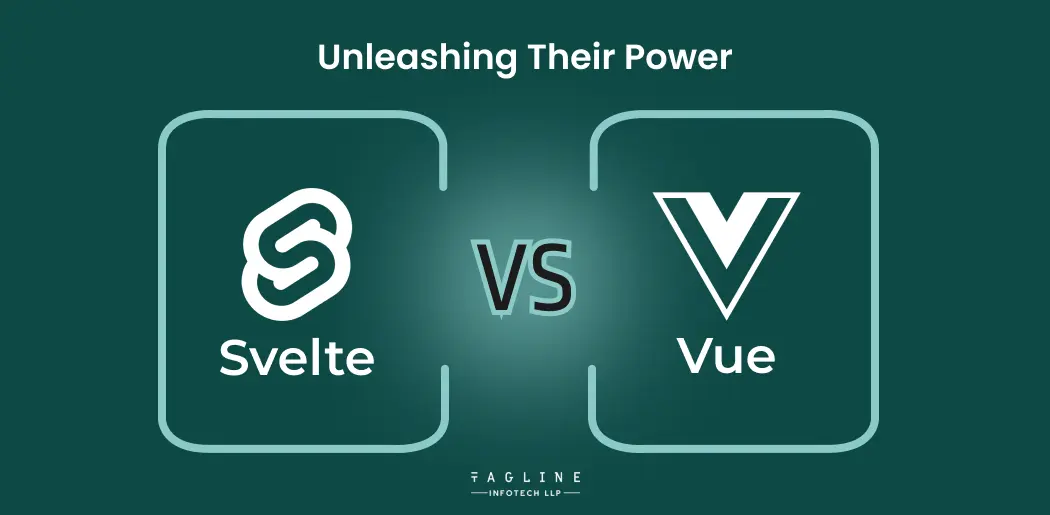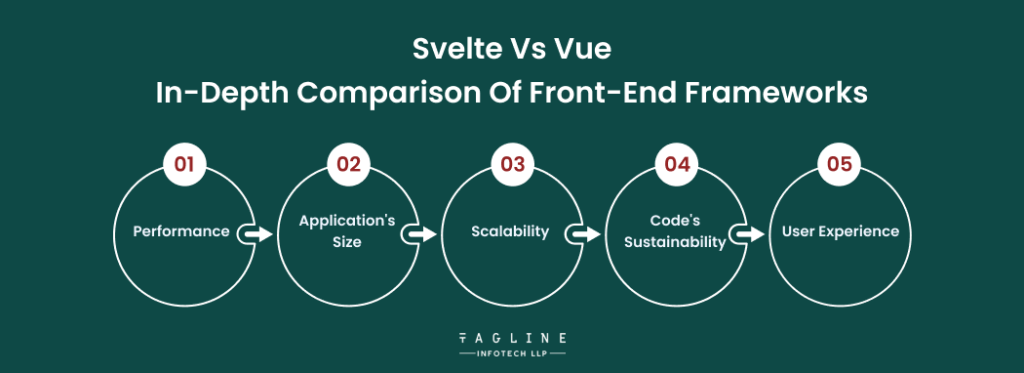Top Node.js Development Companies in India
November 15, 2024
Home >> Vue.Js >> Svelte vs Vue: Unleashing Their Power

Quick Summary
Nowadays, JavaScript frameworks have become the backbone for making scalable and robust apps in today’s web app development; with the changing possibilities, developers often face confusion when it comes to choosing the right framework. The debate between Svelte vs Vue highlights two popular competitors in this field. Both frameworks offer great features and tools to streamline the development process and provide a better user experience.
The frontend frameworks are constantly evolving to allow developers to use better technologies and tools for creating excellent user interfaces. One of the frameworks that is gaining a lot of popularity and attention nowadays is Svelte.
Svelte deviates from the conventional frontend framework approach, opting for a unique method of constructing user interfaces. It transfers the computational workload from the browser to the build step. Unlike sending a hefty framework to the client’s browser, Svelte compiles your code into streamlined, highly optimized JavaScript. This results in faster execution and minimal memory usage.
Here is the list of critical features related to the Svelte
| Features | Description |
|---|---|
| Compiler-based Approach | Svelte compiles apps to efficient, direct DOM-interacting JavaScript during build, boosting performance |
| Reactive Programming | Svelte’s reactivity automates UI updates with minimal manual DOM handling and simplified state management. |
| Component-based Architecture | It’s enables modular development with self-contained elements for easy maintenance and reuse. |
| Transition and Animation Support | Svelte offers built-in support for seamless transitions, animations, and property updates. |
Web developers have been using the sophisticated JavaScript framework Vue.js, which has witnessed a sharp increase in popularity in recent years. Because of its user-friendly interface, versatility, and ease of customization, Vue has quickly become the platform of choice for developing online apps.
That’s why Vue.js, created in 2014 by Evan You, is sometimes called the “React killer” because it works similarly and is very easy to use. Nonetheless, Vue sets itself apart from competing frameworks by using fewer resources and being more straightforward, even for inexperienced coders. It is, therefore, a fantastic substitute for both seasoned web developers and those who are just getting started in the industry.
Here are some of the features related to the Vue
| Features | Description |
|---|---|
| Reactive Data Binding | Vue.js enables effortless data synchronization, creating dynamic, interactive user interfaces |
| Component-Based Architecture | The framework uses a component-based approach, improving testability, maintainability, and reusability for complex applications |
| Vue Router | Vue.js uses Vue Router for seamless client-side routing, enabling smooth view transitions without page refreshes |
| Directives | The framework enables declarative directives like v-bind, v-if, and v-for for simplified DOM manipulation, making looping, data binding, and conditional rendering in components easy |
| Vuex | Vuex, Vue.js’ official state management library, centralizes control over the global state, simplifying debugging and testing |
| Declarative Rendering | Vue.js simplifies code understanding and maintenance with its declarative approach to UI structure and behavior |
“What is Vue.js? Why Vue.js is the Future of Front-End Development “
– Also Read Article

When it comes to operating apps faster, both JavaScript frameworks are highly beneficial. However, Vue vs Svelte shows that Svelte’s performance is significantly higher with much less runtime code. This kind of compiler can both write and optimize the principle that it generates at the same time. It instantly produces better graphics and transitions as a result.
However, Vue utilizes virtual DOM, a method typically employed to increase an application’s overall efficiency. Put differently, it makes websites load faster, enhances the way web pages are rendered, and expedites the upgrading process. Furthermore, Vue provides lazy loading via dynamic imports and reactive data bindings, aiding component development.
While Vue develops somewhat big application bundles (about 30 KB when gzipped), Svelte generates comparatively modest application bundle sizes (around 6 KB when gzipped). Faster loading is optimized with the help of the Svelte compiler, which only includes the required code, reducing the need for extra libraries and frameworks.
Large-scale and intricate application management is more straightforward with Vue’s features and broader ecosystem. It has a smaller memory footprint than rival JavaScript frameworks, and it can support larger and lighter applications.
Due to their respective communities’ recognition as important frontend frameworks, Vue and Svelte are both promoted through open source. Nevertheless, because of its innovative features, Vue has taken the lead. Vue is more consumer-facing than Svelte because it has been around for a while.
Its community for web application development is larger and more engaged than other communities. Meanwhile, Svelte is a relatively new framework that provides features that are both unique and incredibly contemporary. A survey on Github found that Vue has an adoption rate of 18.82% while Svelte has an adoption rate of 4.58%.
Vue and Svelte are very dissimilar in how long their code lasts. The optimization of the code enhances the resilience of the slimline code sustainability during compilation and the removal of unnecessary abstractions.
Conversely, Vue guarantees effective UI modifications by encouraging code sustainability with its enhanced ecosystem and virtual DOM enhancements. This maintains the user interface up to date all the time. It also makes it possible to use reusable Vue components, which significantly simplifies the management of large projects.
The most crucial step in the front-end development process is the user experience. The Vue framework enables a dynamic and responsive user interface (UI), while the Svelte framework boasts an updated UI design. Svelte components update the content immediately, eliminating the need for virtual DOM and reducing loading time.
However, modifications can be implemented inside apps thanks to Vue’s virtual DOM. It is also a reactive variable, and how it interacts with HTML elements adds to the visually pleasing experience for the user.
Ready to level up your web development projects?
Hire expert team and experience the true power of web development with us!
Well-known JavaScript frameworks Vue and Svelte are made to improve user experience by offering robust features and functionalities. It may be challenging to decide between Svelte and Vue because both frameworks excel at providing excellent performance and user interfaces. It becomes hard to choose a framework because of this.
As a result, you should select the framework—Vue. Js or Svelte. Js—according to the specifications of your project, including the application’s size, performance requirements, and level of community support. Hiring a Vue.js development company is a possibility if you want to make an application that is outstanding and active. Tagline guarantees engaging interfaces and can easily give customized solutions to meet your needs.

Digital Valley, 423, Apple Square, beside Lajamni Chowk, Mota Varachha, Surat, Gujarat 394101
D-401, titanium city center, 100 feet anand nagar road, Ahmedabad-380015
+91 9913 808 2851133 Sampley Ln Leander, Texas, 78641
52 Godalming Avenue, wallington, London - SM6 8NW